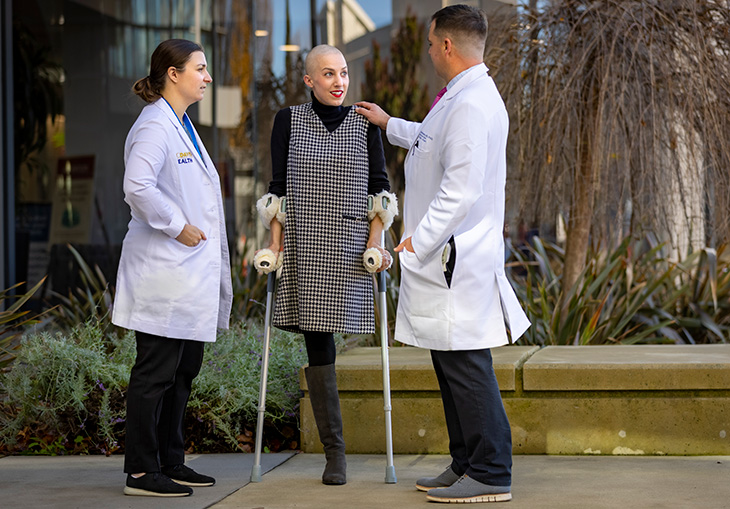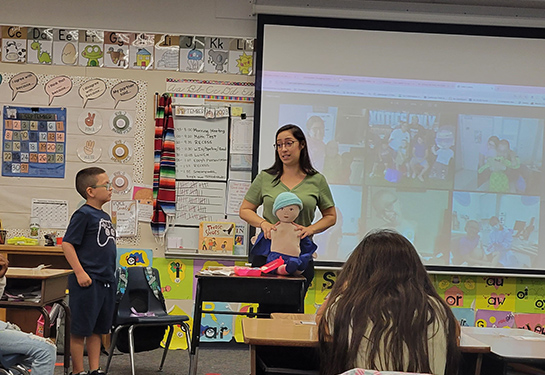Limb Loss and Limb Difference Awareness Month
One woman’s story is shaped by 3D surgical technology
April is Limb Loss and Limb Difference Awareness Month. Every day more than 500 people in the U.S. lose a limb. By 2050, the Amputee Coalition estimates that the number of people with limb loss will nearly double.
The loss of a limb can happen for numerous reasons—everything from an accident to diabetes or even cancer. What is important to know is that people who lose a limb can thrive thanks to medical advancements and emotional support.
Painful symptoms lead to difficult diagnosis

In December 2021, Melissa Kendall, a dental hygienist living and working in the Sierra foothills, started having pain when she walked. By January the pain had progressed to a limp.
An active, healthy then 36-year-old, Kendall knew something was wrong. She went to her local primary care doctor who sent her to physical therapy. Bone cancer was not suspected due to her age because sarcoma usually strikes children or young adults in their early 20s.
“PT didn’t help alleviate the pain, but I had a wedding to focus on,” Kendall said. “My busy life took priority.”
Minor mishap reveals major diagnosis
In February 2022, Kendall and her husband, Jim, were married and soon a rescue puppy named Loki joined the family.
In May, their world turned upside down.
“My pelvis became so weak that it fractured one day with a simple twisting motion when my dog’s leash was caught in the wheel of our golf cart, and I was pulled suddenly in one direction,” Kendall described.
The injury during the outing with Loki is what led to a cancer diagnosis.
Scans were performed to determine why her pelvis shattered so easily. That’s when a mass was detected. A needle core biopsy followed to identify the type of tumor, which would help determine the best course of treatment.
“I was diagnosed with a cancer known as undifferentiated pleomorphic sarcoma of the bone,” Kendall said, with the tone of someone who had educated herself thoroughly about the disease.
She explained that the word “undifferentiated” is used because the cancer cells do not resemble other types of sarcomas. The term “pleomorphic” refers to the cells growing in different sizes and shapes. It was a rare and aggressive sarcoma.
‘Avengers’ team assembled
The cancer center’s sarcoma services group was brought in immediately to review Kendall’s complex case. The team included radiation oncology, medical oncology, and other surgeons who focus and specialize in the treatment of sarcoma.
UC Davis Health surgeon Steven Thorpe, an associate professor with the Department of Orthopaedic Surgery was assigned to lead a team that Kendall later named her “Avengers.”

“Chemotherapy was started right away, to decrease the risk of metastasis and hopefully to shrink the tumor, but this cancer is notoriously resistant to treatment, and it grew. The tumor invaded not only the pelvis but also part of Melissa’s sacrum,” Thorpe said. “I let her know what was at stake and I recommended an external hemipelvectomy and partial sacrectomy, which meant removing her pelvis along with partial removal of the sacrum and her leg.”
It was a life-changing moment.
“Dr. Thorpe gave me all the information to make the decision,” Kendall said. “I relied on my faith and prayed about what I should do. It was a big decision but ultimately, with the support of my family, I decided to proceed with the surgery, which I knew would leave me with only one leg.”
Thorpe pulled together the team that would see Kendall through the day-long surgery. It included experts in urology, orthopaedic spine surgery, general surgery, and plastic surgery.
One of the team members was Osama Raslan, an associate professor in the Department of Radiology. He specializes in using advanced 3D radiographic imaging technologies like 3D printing and augmented reality. His goal is to help surgeons plan and safely execute complex surgical procedures such as hemipelvectomies while sparing as much healthy tissue as possible.
3D model of her pelvis helped prep for surgery
Raslan and his biomedical engineering partner Steven Lucero used Kendall’s CT and MRI images to create a real-life 3D printed replica of her pelvic region. It was complete with the tumor, major arteries, veins, and nerves running along the tumor. Both Raslan and Lucero work in the UC Davis 3D Printing and Visualization lab.

Using specialized software and a CT scan of Kendall’s pelvis, Raslan meticulously defined the boundaries of the normal bone, the tumor, and the surrounding critical structures. The computer then generated a digital 3D replica of these structures, which the team reviewed and authenticated before the replica of her pelvic region was created.
Raslan said the size and location of Kendall’s tumor were unique. It was very closely connected to the major arteries, veins and nerves that supply the pelvis and left leg.
The model not only helped surgeons prepare for her complex surgery, it was also used to help Kendall’s family visualize what she was undergoing while they waited for her to come out of surgery.
Due to her positive attitude, faith and family support, Melissa was able to go home from the hospital earlier than expected.
Looking ahead to an exciting future
“Dr. Thorpe encouraged me every step of the way, which helped keep up my spirit. His fist bumps and high fives really meant a lot to me. And even though we all wore masks, Dr. Thorpe’s eyes tell you he is in it wholeheartedly,” Kendall said.
The Auburn resident is in physical therapy and is hoping to return to many of the outdoor activities she loves, thanks to a prosthetic leg and a lot of rehabilitation. That includes skiing at nearby Tahoe resorts.
Through social media, Kendall has connected with other hemipelvectomy patients, including one woman who after her surgery was able to become pregnant and have two sons.
“That’s one of my goals — to be a mother,” Kendall said. "I feel so supported at UC Davis Health as I pursue starting my own family. My ‘Avengers’ saved my life, and I will be forever grateful."
UC Davis Comprehensive Cancer Center
UC Davis Comprehensive Cancer Center is the only National Cancer Institute-designated center serving the Central Valley and inland Northern California, a region of more than 6 million people. Its specialists provide compassionate, comprehensive care for more than 100,000 adults and children every year and access to more than 200 active clinical trials at any given time. Its innovative research program engages more than 240 scientists at UC Davis who work collaboratively to advance discovery of new tools to diagnose and treat cancer. Patients have access to leading-edge care, including immunotherapy and other targeted treatments. Its Office of Community Outreach and Engagement addresses disparities in cancer outcomes across diverse populations, and the cancer center provides comprehensive education and workforce development programs for the next generation of clinicians and scientists. For more information, visit cancer.ucdavis.edu.



